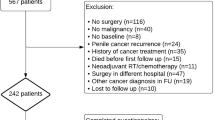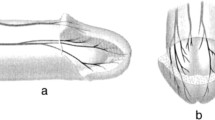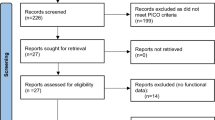Abstract
The first-line treatment of penile cancer confined to the glans (Tis-T2) is based on organ-sparing approaches. Our aim is to report functional outcomes of total glans resurfacing (TGR), wide local excision (WLE) and glansectomy. A retrospective analysis was conducted from January 2013 to October 2022. Ninety-nine patients were enrolled (22 TGR, 29 WLE, and 48 glansectomy). Sexual and urinary outcomes were explored using ad hoc and validated questionnaires (IIEF-15 and IPSS). The mean follow-up was 25.28 ± 24.87 months [95% CI: 20.38; 30.18]. 44 patients (12 TGR, 10 WLE, and 22 glansectomy) were assessed for functional outcomes. Overall, 86.36% of patients were satisfied with the surgery. The mean IIEF-15 score pre-operation was 54.91 ± 21.38 [95% CI: 48.41–61.41], and at 12 months post-operation, it was 44.39 ± 23.01 [95% CI: 37.39–51.39], with the change being statistically significant (mean difference: –10.52, (–19.15), p < 0.001). During the 0–12-month interval, IIEF-15 scores decreased across all techniques. Glansectomy and WLE showed significant decreases (Glansectomy: –12.955, –24.14%, [95% CI: –21.52, –4.38], p = 0.002; WLE: –14.1, –22.92%, [95% CI: –26.8, –1.39], p = 0.025 respectively), whereas TGR experienced a non-significant decrease (–3.083, –5.97%, CI: [–14.68, 8.51], p = 1.0). Concerning urinary function, only 18.18% of overall patients reported a negative impact of surgery. At 12-months, patients returned almost to pre-intervention IPSS values. Organ-sparing surgery guarantees a decent preservation of both erectile and voiding functions. TGR seems to provide better sexual outcomes when compared to other organ sparing approaches.
This is a preview of subscription content, access via your institution
Access options
Subscribe to this journal
Receive 12 print issues and online access
$259.00 per year
only $21.58 per issue
Buy this article
- Purchase on SpringerLink
- Instant access to full article PDF
Prices may be subject to local taxes which are calculated during checkout


Similar content being viewed by others
Data availability
The data that support the findings of this study are available from the corresponding author (M.F.) upon reasonable request.
References
Olesen TB, Sand FL, Rasmussen CL, Albieri V, Toft BG, Norrild B, et al. Prevalence of human papillomavirus DNA and p16INK4a in penile cancer and penile intraepithelial neoplasia: a systematic review and meta-analysis. Lancet Oncol. 2019;20:145–58.
Douglawi A, Masterson TA. Updates on the epidemiology and risk factors for penile cancer. Transl Androl Urol. 2017;6:785–90.
EAU-ASCO Penile Cancer Guidelines. Edn. presented at the EAU Annual Congress Paris 2024. ISBN 978-94-92671-23-3.
Sri D, Sujenthiran A, Lam W, Minter J, Tinwell BE, Corbishley CM, et al. A study into the association between local recurrence rates and surgical resection margins in organ-sparing surgery for penile squamous cell cancer. BJU Int. 2018;122:576–82.
Pang KH, Muneer A, Alnajjar HM. Glansectomy and reconstruction for penile cancer: a systematic review. Eur Urol Focus. 2022;8:1318–22.
Minhas S, Kayes O, Hegarty P, Kumar P, Freeman A, Ralph D. What surgical resection margins are required to achieve oncological control in men with primary penile cancer? BJU Int. 2005;96:1040–3.
Philippou P, Shabbir M, Malone P, Nigam R, Muneer A, Ralph DJ, et al. Conservative surgery for squamous cell carcinoma of the penis: resection margins and long-term oncological control. J Urol. 2012;188:803–8.
Raskin Y, Vanthoor J, Milenkovic U, Muneer A, Albersen M. Organ-sparing surgical and nonsurgical modalities in primary penile cancer treatment. Curr Opin Urol. 2019;29:156–64.
Opjordsmoen S, Fosså SD. Quality of life in patients treated for penile cancer. A follow-up study. Br J Urol. 1994;74:652–7.
Kieffer JM, Djajadiningrat RS, van Muilekom EAM, Graafland NM, Horenblas S, Aaronson NK. Quality of life for patients treated for penile cancer. J Urol. 2014;192:1105–10.
Sansalone S, Silvani M, Leonardi R, Vespasiani G, Iacovelli V. Sexual outcomes after partial penectomy for penile cancer: results from a multi-institutional study. Asian J Androl. 2017;19:57.
Gulino G, Sasso F, Palermo G, D’Onofrio A, Racioppi M, Sacco E, et al. Sexual outcomes after organ potency-sparing surgery and glans reconstruction in patients with penile carcinoma. Indian J Urol. 2013;29:119–23.
Pérez J, Chavarriaga J, Ortiz A, Orrego P, Rueda S, Quiroga W, et al. Oncological and Functional Outcomes After Organ-Sparing Plastic Reconstructive Surgery for Penile Cancer. Urology. 2020;142:161–5.e1.
Rosen RC, Riley A, Wagner G, Osterloh IH, Kirkpatrick J, Mishra A. The international index of erectile function (IIEF): a multidimensional scale for assessment of erectile dysfunction. Urology. 1997;49:822–30.
Barry MJ, Fowler FJ, O’leary MP, Bruskewitz RC, Holtgrewe HL, Mebust WK, et al. The American Urological Association Symptom Index for Benign Prostatic Hyperplasia. Journal of Urology [Internet]. 2017 Feb [cited 2022 May 5]; 197(2S). Available from: http://www.jurology.com/doi/10.1016/j.juro.2016.10.071.
Mortensen GL, Jakobsen JK. Patient perspectives on quality of life after penile cancer. Dan Med J. 2013;60:A4655.
Lindner AK, Schachtner G, Steiner E, Kroiss A, Uprimny C, Steinkohl F, et al. Organ-sparing surgery of penile cancer: higher rate of local recurrence yet no impact on overall survival. World J Urol. 2020;38:417–24.
Baumgarten A, Chipollini J, Yan S, Ottenhof SR, Tang DH, Draeger D, et al. Penile sparing surgery for penile cancer: a multicenter international retrospective cohort. J Urol. 2018;199:1233–7.
Anastasiadis E, Ayres B, Watkin N. Update on penile sparing surgery for penile cancer. Curr Opin Urol. 2022;32:1–7.
Janssen MF, Szende A, Cabases J, Ramos-Goñi JM, Vilagut G, König HH. Population norms for the EQ-5D-3L: a cross-country analysis of population surveys for 20 countries. Eur J Health Econ. 2019;20:205–16.
Huang W, Wang Q, Chen J, Wu P. Development and validation of the International Consultation on Incontinence Modular Questionnaire for Male Lower Urinary Tract Symptoms (ICIQ‐MLUTS) and the ICIQ‐MLUTS Long Form in Chinese population. LUTS. 2019;11:189–94.
Morelli G, Pagni R, Mariani C, Campo G, Menchini-Fabris F, Minervini R, et al. Glansectomy with split-thickness skin graft for the treatment of penile carcinoma. Int J Impot Res. 2009;21:311–4.
Beech BB, Chapman DW, Rourke KF Clinical outcomes of glansectomy with split-thickness skin graft reconstruction for localized penile cancer. CUAJ [Internet]. 2019 Nov 8 [cited 2022 May 20]; 14(10). Available from: https://cuaj.ca/index.php/journal/article/view/6277.
Wan X, Zheng D, Liu C, Xu H, Xie M, Zhou J, et al. A Comparative study of two types of organ-sparing surgeries for early stage penile cancer: Wide local excision vs partial penectomy. Eur J Surgical Oncol. 2018;44:1425–31.
Althof SE, Cappelleri JC, Shpilsky A, Stecher V, Diuguid C, Sweeney M, et al. Treatment responsiveness of the Self-Esteem And Relationship questionnaire in erectile dysfunction. Urology. 2003;61:888–92.
Aaronson NK, Ahmedzai S, Bergman B, Bullinger M, Cull A, Duez NJ, et al. The European Organization for Research and Treatment of Cancer QLQ-C30: A Quality-of-Life Instrument for Use in International Clinical Trials in Oncology. JNCI J Natl Cancer Inst. 1993;85:365–76.
Palminteri E, Berdondini E, Lazzeri M, Mirri F, Barbagl G. Resurfacing and Reconstruction of the Glans Penis. Eur Urol. 2007;52:893–900.
Author information
Authors and Affiliations
Contributions
MF, MP, and PG designed the experiments and helped supervise the project. MF, MG, AS, and MS wrote the manuscript and performed the computations. MG and AS verified all the statistical analyses. MS, LC, FP, IF, and NP participated in data collection. All authors discussed the results and contributed to the final manuscript.
Corresponding author
Ethics declarations
Competing interests
The author declares no competing interests.
Ethics approval and consent to participate
We declare that all methods were performed in accordance with the relevant guidelines and regulations. The study was authorized by the local ethics committee (N°00235/2021). We declare that each patient provided informed consent to undergo the surgical procedure and to authorize the publication of their data. Written informed consent was obtained for taking photos in the operating room and for the publication of these images. This consent is separate from the consent to participate in the study.
Additional information
Publisher’s note Springer Nature remains neutral with regard to jurisdictional claims in published maps and institutional affiliations.
Supplementary information
Rights and permissions
Springer Nature or its licensor (e.g. a society or other partner) holds exclusive rights to this article under a publishing agreement with the author(s) or other rightsholder(s); author self-archiving of the accepted manuscript version of this article is solely governed by the terms of such publishing agreement and applicable law.
About this article
Cite this article
Falcone, M., Preto, M., Gül, M. et al. Functional outcomes of organ sparing surgery for penile cancer confined to glans and premalignant lesions. Int J Impot Res 37, 736–744 (2025). https://doi.org/10.1038/s41443-024-00967-7
Received:
Revised:
Accepted:
Published:
Issue date:
DOI: https://doi.org/10.1038/s41443-024-00967-7
This article is cited by
-
“Sexuality in penile cancer: lessons learned and the road ahead”
International Journal of Impotence Research (2025)
-
Patient-reported outcome measures in penile cancer: a narrative review
International Journal of Impotence Research (2025)
-
Functional outcomes of glansectomy to treat localised penile cancer: a systematic review
International Journal of Impotence Research (2025)



